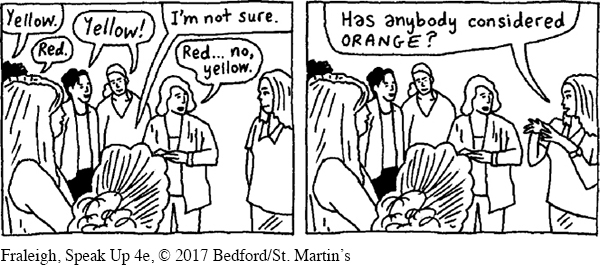Managing Conflict
Whatever the situation or setting, disagreements inevitably crop up as a group works together on a project. Some conflict is helpful. For example, when members express honest disagreement about proposed plans of action, they help minimize the risk of groupthink. But interpersonal conflicts that have nothing to do with the group’s mission can create distractions. Whenever conflict arises in your group, strive to minimize it or channel it in a productive direction. The following guidelines can help.

Page 619

Refer to Ideas by Topic, Not by Person. Focus on the content of specific suggestions rather than attributing those suggestions to individual members. For example, suppose you’re part of a group that’s trying to get a candidate elected as head of the town council. Monique advocates sending a mass email to build support for the candidate, but Tim thinks that leafleting would be better. Refer to these ideas as “the email plan” and “the leafleting plan” rather than “Monique’s idea” and “Tim’s suggestion.” When ideas get associated with an individual, that person may develop a feeling of personal investment in that option. He or she may thus become defensive if the proposal is criticized—

Resolve Conflicts Quickly. If a conflict between group members becomes distracting, try to resolve it rather than allowing it to continue or repressing it. Give the members who disagree an equal opportunity to explain their perspective; let each person speak without interruption, and then ask other members for their views. If both people’s ideas have merit, perhaps you can help the group find a solution that draws the best from each perspective. As leader, you may ultimately need to offer your opinion or vote to break a deadlock on an issue, but try to give group members an opportunity to speak before injecting your opinion.
Page 620

Focus on Tasks, Not Disagreements. Help members concentrate on the task at hand rather than on interpersonal tensions that may be simmering. Rather than criticizing individuals (by saying things like, “Sally, your answers to Noah’s questions are always sarcastic”), articulate desired changes in behavior (by saying things like, “Let’s get back to discussing our project”).
A personality clash may be best solved by discussing the problem in private with the members who disagree rather than airing the conflict in front of the entire group. If a member gets along well with the people experiencing the conflict, she or he may be able to help them find a way to manage their disagreement.
Manage Disruptive Emotions. Conflicts can spark intense and disruptive emotions within a group. Even after a conflict has been resolved, members may still feel angry, upset, or embarrassed and may withdraw from the discussion. If this happens, bring reluctant members back into the discussion by inviting their input on important issues.

Seek to Create a Diverse Group Atmosphere. Working with others allows us to draw on everyone’s unique experiences and perspectives. Group members with different ideas can tackle complex problems by offering up, weighing, and trying out multiple solutions. Greater group heterogeneity, or member difference (as compared to homogeneity, or member similarity), is not without its challenges. In groups that are highly heterogeneous, members may have to provide more background information for their ideas and may be more likely to disagree with one another. But although homogeneous groups may run more smoothly, heterogeneous groups find ways to coordinate multiple perspectives more productively.4 In other words, a group with diverse perspectives that values all of those perspectives and is able to use them effectively has the best chance of reaching their goals.
Page 621